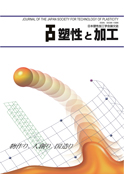
- |<
- <
- 1
- >
- >|
-
Masayuki HORIE, Yukuya TAMURA, Toshihiro MIWA, Masaru MIYAKE, Kazuhisa ...2018Volume 59Issue 694 Pages 203-208
Published: 2018
Released on J-STAGE: November 26, 2018
JOURNAL FREE ACCESSTo improve the productivity of the press bending process, that is the method of forming a longitudinally welded large-diameter pipe from heavier thickness and higher strength plate, decreasing the number of press steps is required. However, with decreasing the number of press steps, the unevenness of pipe roundness becomes greater. Therefore, to clarify the influence of the number of press steps on the expansion process with 12 dies, the expansion process of a pipe with the shape of a cyclic arc with a straight region is investigated. With increasing number of press steps, unevenness of the press-bend pipe decreases, but the crossing force during expansion and unevenness of the expanded pipe are less in the case of the pipe formed with 11 steps. In this case, all dies are in contact with the straight region equally at the beginning of expansion, and the crossing force is the less. Furthermore, the entire die surface is in contact with the pipe at the end of expansion, and unevenness of the expanded pipe is less. To implement this surface contact, the ratio of the radius of the arc to the pipe inner diameter should be larger than 0.8. From these results, the number of press steps on press bending process can be decreased to 11, which means the productivity of the press bending process should increase dramatically.
View full abstractDownload PDF (1274K) -
―Development of Forming Technology for Tailor-Welded Blank Application 2nd Report―Masahiro SAITO, Yoshiaki NAKAZAWA, Kenichiro OTSUKA, Masanori YASUYAMA ...2018Volume 59Issue 694 Pages 209-214
Published: 2018
Released on J-STAGE: November 26, 2018
JOURNAL FREE ACCESSThe stretch flangeability of tailor-welded blank depends on the angle between weld line and the tangential line of blank edge, which is generally the tensile direction in stretch flanging. This effect was studied by uniaxial tensile testing of tailor-welded high-strength-steel specimens with a weld line at 45, 60, or 90 degrees from the tensile direction. The 60-degree-weld-line specimen provides the highest elongation at the maximum load. This is the angle at which the strain component in the weld-line direction is close to zero. At the other angles, the weld lines, of which hardness sufficiently increases by welding, play a role as a constraint for vicinal base metal. This leads to early strain localization and low elongation. Furthermore, the elongation at the maximum load can, in some cases, exceed the uniform elongation of base metal. This is pronounced by a base metal with a low n-value.
View full abstractDownload PDF (1850K) -
Kenji FUCHIWAKI, Yuji MURE, Kazunari YOSHIDA2018Volume 59Issue 694 Pages 215-220
Published: 2018
Released on J-STAGE: November 26, 2018
JOURNAL FREE ACCESSFine blanking (FB) is well known as a method for obtaining a clean-cut edge in the manufacture of a plate-like part having a sliding portion and/or a fitting portion on the side face of the part. However, FB in general is disadvantageous for good usage of precious steel material because of the unavoidable large web width. Accordingly, to manufacture precision plate-like parts with high material usage, first, a strip material having a thickness corresponding to the thickness of the finished product was cut from the coil material. Then, forming was carried out from the side of the plate surface with a punch and a knock -out punch in which the shape close to the final product was divided into approximately half. Thereafter, the forged product, which includes the defects from cutting, was blanked into the final product shape while being restrained by part of the side wall of the die. The method resulted not only in precious stainless-steel components,such as small arms used in large number in an automobile turbocharger, each having a clean-cut edge without fracture along the sheet thickness, but also in drastically improved material usage.
View full abstractDownload PDF (1936K) -
Yuki NAKAGAWA, Ken-ichiro MORI, Tomoyoshi MAENO, Ryo UMEMIYA2018Volume 59Issue 694 Pages 221-227
Published: 2018
Released on J-STAGE: November 26, 2018
JOURNAL FREE ACCESSThe effects of hot trimming conditions on the sheared-edge quality and mechanical properties in hot stamping of ultra-high strength steel parts were examined. In hot stamping, the temperature of the parts rapidly drops during stamping, and the subsequent trimming operation is greatly influenced by the temperature. The sheared-edge quality was high above the temperature at which the martensitic transformation starts for a comparatively small clearance. The trimming temperature had a great influence on the occurrence of delayed fracture, whereas the clearance had no influence. In hot trimming, delayed fracture was prevented by decreasing the tensile residual stress and hardness near the sheared edge. The static and fatigue strengths of the parts are reduced by delayed cracks and hydrogen embrittlement, whereas the fatigue limit is unaffected. In hot trimming of thin sheets, delayed fracture tends to occur as a result of a large temperature drop.
View full abstractDownload PDF (1491K)
- |<
- <
- 1
- >
- >|